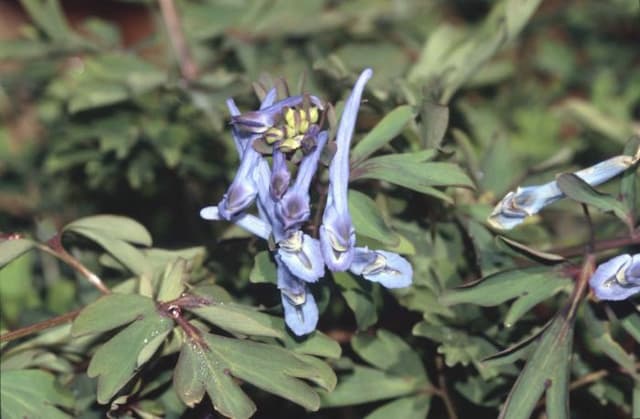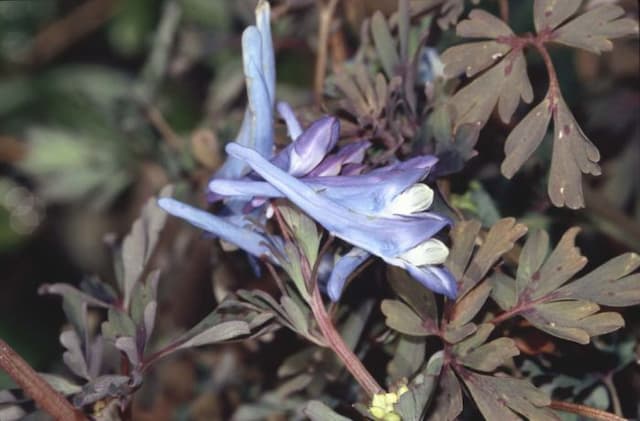Hollowroot Corydalis cava

ABOUT
Corydalis cava, commonly known as hollowroot, is notable for its delicate and attractive appearance. It produces a rosette of compound leaves that are finely divided, giving them a feathery look. These leaves are generally green but may have a hint of blue. The most striking aspect of the hollowroot is its flowers, which appear in early spring. They are tubular and have a distinct, spurred shape, resembling small, elongated helmets. The flowers come in a soft range of colors, typically in shades of pink, purple, and white. Sometimes, the petals display subtle patterning or veins, which can add to their ornamental value. The plant's underground structure includes a tuber that gives rise to the common name "hollowroot." Above the ground, the stems are rather slender, supporting the weight of the flowers and leaves subtly, often blending into the natural background of its wooded environments. The overall impression of the hollowroot is of a delicate and ephemeral beauty, as it blooms early and the above-ground parts die back later in the year, leaving no trace above ground until the next spring.
About this plant
 Names
NamesFamily
Papaveraceae.
Synonyms
Hollowroot, Hollow-root, Holewort.
Common names
Corydalis bulbosa, Corydalis cava subsp. marschalliana, Corydalis cava subsp. schanginii, Corydalis cavernosa, Corydalis intermedia, Corydalis marschalliana, Corydalis schanginii, Fumaria bulbosa, Fumaria cava, Fumaria cavernosa, Fumewort bulbosa.
 Toxicity
ToxicityTo humans
Hollowroot is considered to be potentially toxic to humans if ingested in large quantities. The plant contains several alkaloids, such as corydaline and bulbocapnine, which can have toxic effects. Symptoms of hollowroot poisoning can include sedation, nausea, vomiting, and diarrhea. In severe cases, excessive consumption could lead to convulsions, respiratory failure, and even death.
To pets
Hollowroot is also potentially toxic to pets. The alkaloids present in the plant, such as corydaline and bulbocapnine, can be harmful if consumed. Symptoms of hollowroot poisoning in pets may include gastrointestinal upset, such as vomiting and diarrhea, central nervous system depression, which could lead to signs like sedation or tremors, and in severe cases, convulsions, difficulty breathing, and death. It is important to keep pets away from this plant to ensure their safety.
 Characteristics
CharacteristicsLife cycle
Perennials
Foliage type
Deciduous
Color of leaves
Green
Flower color
Purple
Height
4-8 inches (10-20 cm)
Spread
4-6 inches (10-15 cm)
Plant type
Bulb
Hardiness zones
5
Native area
Europe
Benefits
 General Benefits
General Benefits- Aesthetic Value: Corydalis cava, also known as hollowroot, adds visual interest to gardens with its attractive foliage and flowers.
- Attracts Pollinators: Its blooms can attract beneficial insects such as bees, which are important for pollination.
- Natural Ground Cover: Hollowroot can serve as ground cover in woodland gardens, helping to suppress weeds and reduce soil erosion.
- Biodiversity: By providing habitat and food for wildlife, it contributes to the biodiversity of the garden ecosystem.
 Medical Properties
Medical Properties- Analgesic: Corydalis cava contains alkaloids that may have pain-relieving properties.
- Sedative: It has been traditionally used as a mild sedative, helping to promote relaxation and sleep.
- Antispasmodic: The plant may help in relieving muscle spasms and cramps.
- Anxiolytic: It might have a calming effect on anxiety and stress-related conditions.
 Air-purifying Qualities
Air-purifying QualitiesThis plant is not specifically known for air purifying qualities.
 Other Uses
Other Uses- Corydalis cava (Hollowroot) bulbs have been used as a starch substitute in times of scarcity. The bulb contains a nutritious starch that can be extracted and used in cooking similar to traditional starches.
- The plant's tuber can serve as a food source for wildlife. In its natural habitat, the tubers of Hollowroot might be foraged by wild animals seeking a carbohydrate-rich food source.
- As a natural dye, the Hollowroot plant has been explored for its pigment potential. The roots can sometimes yield a dye for traditional craftspeople.
- In the garden, Hollowroot can be planted as an ornamental species, providing early spring flowers under trees and shrubs before the canopy closes in.
- It can be used in woodland restoration projects, with its natural tendency to spread in shady areas, it can help in re-establishing native undergrowth in forested areas.
- The dried plant material of Corydalis cava can be incorporated into potpourri mixes for a natural and earthy aroma.
- Due to its unique shape, the bulbs of Hollowroot can be used in educational settings to teach about plant morphology and root structures.
- In sustainable landscaping, Corydalis cava can play a role in soil stabilization in wooded settings, with its root system helping to prevent soil erosion.
- Hollowroot is sometimes used in flower arrangements and botanical art for its visually interesting foliage and flowers.
- The fragrance of its blossoms can attract certain species of bees and beneficial insects, thus promoting biodiversity within a garden ecosystem.
Interesting Facts
 Feng Shui
Feng ShuiCorydalis is not used in Feng Shui practice.
 Zodiac Sign Compitability
Zodiac Sign CompitabilityCorydalis is not used in astrology practice.
 Plant Symbolism
Plant Symbolism- Hope: Corydalis cava, also known as Hollowroot, is often associated with hope due to its capacity to emerge from the cold ground in early spring, acting as a symbol of overcoming adversity.
- Joy: The vibrant flowers of the Hollowroot bring joy to those who encounter them after a long, dark winter, symbolizing the cheerfulness and pleasure found in nature’s resilience.
- Transition: Hollowroot's blooming period marks the transition from winter to spring, thus representing change and the natural flow of life’s seasons.
 Water
WaterThe hollowroot appreciates soil that remains evenly moist but is not waterlogged. During the growing season, water your hollowroot when the top inch of soil feels dry to the touch. This can typically mean watering once a week with about 1-2 gallons per square yard, depending on the local climate and weather conditions. Over-watering can lead to root rot, so ensure good drainage. During dormancy, after the foliage dies back, reduce watering significantly, only to prevent the soil from completely drying out.
 Light
LightHollowroot thrives best in dappled sunlight or partial shade, mimicking its natural woodland habitat. A spot that receives filtered sunlight through tree branches or partial day exposure, such as morning sun followed by afternoon shade, is ideal. Avoid placing hollowroot in areas with full, direct sunlight which can scorch the leaves and stress the plant.
 Temperature
TemperatureHollowroot favors cool to moderate temperatures and is hardy in a range between 32 degrees Fahrenheit and 75 degrees Fahrenheit. This plant is a spring ephemeral and prefers the cooler temperatures of spring. Prolonged exposure to temperatures above 75 degrees Fahrenheit may lead to dormancy or stress the plant. Ideal growing conditions are those of a temperate woodland, where temperatures are typically cool to mild.
 Pruning
PruningPruning hollowroot is generally not required as the plant is a spring ephemeral and dies back naturally after blooming and setting seed. If desired, the fading foliage can be trimmed back after it has yellowed and died, which typically occurs by midsummer. This helps maintain a tidy appearance and can be done annually.
 Cleaning
CleaningNot needed
 Soil
SoilHoller's poppy thrives in moist, well-drained soil mixed with organic matter like leaf mold or compost. The best soil mix should consist of two parts loam, one part sand, and one part peat or compost to ensure good drainage and fertility. The soil pH should be slightly acidic to neutral, typically around 5.5 to 7.0 for optimum growth.
 Repotting
RepottingHoller's poppy should be repotted every two to three years. It is best done after the flowering season when the plant is dormant, usually from late summer to early autumn. Carefully lift and divide the tubers if necessary, replenishing with fresh soil to encourage healthy growth.
 Humidity & Misting
Humidity & MistingHoller's poppy prefers a moderate humidity level, but it is adaptable and can tolerate the humidity levels typically found in the average home or garden. Avoid extremely high humidity environments, which can encourage fungal diseases.
 Suitable locations
Suitable locationsIndoor
Place Holler's poppy in bright, indirect light and keep the soil moist.
Outdoor
Plant Holler's poppy in dappled sunlight and well-draining soil.
Hardiness zone
5-9 USDA
 Life cycle
Life cycleCorydalis cava, commonly known as hollowroot, begins its life cycle as a bulb-like tuber from which shoots emerge in early spring. The plant quickly produces a rosette of finely divided, fern-like leaves and erect flower stems bearing clusters of tubular purple or white flowers that attract early pollinators. After flowering, the plant sets seed within elongated capsules that burst open when ripe, dispersing seeds a short distance from the parent plant. As a spring ephemeral, hollowroot completes its above-ground growth cycle by late spring or early summer, at which point the foliage dies back and the plant enters a dormant state throughout the hot summer months. During dormancy, the tubers store energy for the next growing season. The cycle resumes the following spring, when new shoots emerge from the tubers to start the process again.
 Propogation
PropogationPropogation time
Spring to early summer
Corydalis cava, commonly known as hollowroot, is typically propagated through its tubers. The best time to propagate hollowroot by tubers is in the fall, after the plant has died back and the tubers have had a chance to mature. To propagate, carefully dig up the tubers, taking care not to damage them. Select healthy tubers and divide them, ensuring that each division has at least one growth point. Then, plant the tubers about 2 inches deep (about 5 centimeters) and space them approximately 4 to 6 inches apart (10 to 15 centimeters). Water them well after planting to encourage establishment. In the right conditions, the new plants should emerge in the following spring, displaying their characteristic purple flowers.









